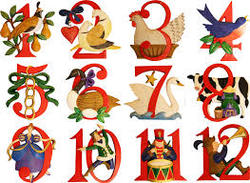Twelve Days of Christmas
 In the song Twelve Days of Christmas, someone’s true love sends a partridge on the first day; two turtledoves and a partridge on the second day; three French hens, two turtledoves and a partridge on the third day. This gift-giving pattern continues for twelve days. How many gifts did the true love send in total?
In the song Twelve Days of Christmas, someone’s true love sends a partridge on the first day; two turtledoves and a partridge on the second day; three French hens, two turtledoves and a partridge on the third day. This gift-giving pattern continues for twelve days. How many gifts did the true love send in total?
The answer is 364.
This section requires Javascript.
You are seeing this because something didn't load right. We suggest you, (a) try
refreshing the page, (b) enabling javascript if it is disabled on your browser and,
finally, (c)
loading the
non-javascript version of this page
. We're sorry about the hassle.
3 solutions
Could you please show me how you got to that?
Log in to reply
Day 1 => 1 present Day 2 => 1 + 2 presents Day 3 => 1 + 2 + 3 presents ... Day n => 1 + 2 + 3 + ... + n = n*(n+1)/2 presents
These are known as triangular numbers. The sum of the first n triangular numbers is given the formula stated. I hope this helps.
Actually I think the Question is wrong it should be how many gifts in total does the true lover sends to his beloved . If it is for how many gifts does the true lover sends by the twelfth day? The solution will obviously be
= 1+2+3+4+5+6+7+8+9+10+11+12
=n/2*(a+l) =78
for the total number of gifts it should be
=1 * 12+2 * 11+3 * 10+4 * 9+5 * 8+6 * 7+7 * 6+8 * 5+9 * 4+10 * 3+11 * 2+12 * 1
=(1 * 12+2 * 11+3 * 10+4 * 9+5 * 8+6 * 7) * 2
=364
This has been written considering that he sends he sends 1 gift on the first on the first day , 1+2 gifts on the second day and so on.
You're right Vaibhav. I have to edit the question.
I fixed the question.
I will use summation by method of differences which i got from the book Higher Algebra by hall and knight .
Log in to reply
Could you explain the method of differences. I would like to know what it is.
Log in to reply
yeah sure i will create a note on it & link it here in few days (i am busy now).
Same here brother even i would like to know summation by method of differences.
On the first day, there is 1 gift. On the second, there is 3, then 6, then 10. These are the triangular numbers.
0 + 1 = 1 1 + 2 = 3 3 + 3 = 6 6 + 4 = 1 0 1 0 + 5 = 1 5
First, there is 0, then keep adding 1, 2, 3, 4, 5, so on, and you will get the triangular numbers. The sum of all of the gifts is obviously the sum of the first 12 triangular numbers, namely, 1 + 3 + 6 + 10 + 15 + 21 + 28 + 36 + 45 + 55 + 66 + 78. The triangular numbers can also be expressed in groups of objects that form triangles.
This is a classic problem. You can show that this general series can be solved by the equation 6 1 ( n ) ( n + 1 ) ( n + 2 ) .